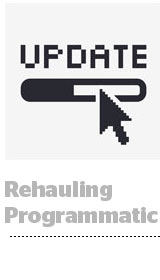 In 2016, Mashable got its programmatic house in order.
In 2016, Mashable got its programmatic house in order.
When Chief Revenue Officer Ed Wise joined Mashable last spring, he immediately noticed that the tech publisher was missing out on a lot of programmatic revenue.
Its viewability scores topped out below industry averages. Mashable sold inventory on the open exchanges blindly, hampering CPMs. And sales teams were instructed to convince advertisers to buy direct, not programmatically.
In the summer, Mashable put some manpower behind its programmatic problem. Wise hired Adam Harris from Collective as SVP of sales strategy and partnerships.
“One of the first problems that Ed asked me to help solve was figuring out how to turn our programmatic inventory into a strong revenue stream,” Harris said.
Harris made a series of technical changes and optimizations. He moved to implement header bidding, adding Amazon, Index Exchange, Rubicon and other partners and folding them into a wrapper. On the open exchanges, Mashable disclosed its URL. That transparency boosted the price that buyers were willing to pay for ads. Mashable also worked with Moat to boost its viewability score from below average to above average.
Together, those changes moved open exchange CPMs from the $1-to-$2 range to the $4-to-$5 range.
On the video side, Mashable picked Amazon as its programmatic partner. Its technology directly integrates with the video player, reducing latency. Mashable is evaluating adding other video partners to unify the auction for video inventory via a header bidding-like setup.
Under Wise, Mashable’s sales team offers inventory however buyers want it served.
“We are agnostic as to how you reach our audience,” Harris said. “We want to make sure clients get the best possible experience, service and the efficiencies they want.”
Mashable’s fast-growing branded content business requires more time to execute, so Wise sees programmatic as a way to counterbalance the increase in resources required for custom work.
“Programmatic has allowed us to free up our time to focus on some of those other executions, like branded content,” Wise said.
Wise filled out Mashable’s sales team with a few hires who have expertise selling programmatic deals. Besides Harris, Mashable hired John Price as VP of revenue operations to aid programmatic ad ops. Its new VP of integrated marketing, Sara Kern, focuses on 360-degree deals, which include programmatic.
In 2017, Mashable is thinking about more ways it can improve its programmatic business. Harris plans to add more demand partners, including on the video side. Server-to-server is an option.
“If the server-to-server solution will allow us to reduce latency on the page and/or increase revenue, we are ready and willing to entertain it,” Harris said.
And although it’s early, Wise is exploring existing opportunities for programmatic in the over-the-top space. He would also like to see Mashable improve its audience data offerings. Currently, direct and programmatic buyers can target ads to social influencers identified through tech that Mashable has dubbed “Kilogram,” its primary data-driven offering. But Mashable could do a lot more.
“We are at the tip of the iceberg, in terms of adding proprietary data to the mix,” Wise said.
Data will also be a way to highlight the value of reaching Mashable’s readers.
“For the longest time in the ad tech business, we’ve focused on programs, technology and efficiencies – and lost sight of how valuable the audience is that the content provider is bringing in,” Harris said.
This post was syndicated from Ad Exchanger.

More Stories
Beyond Cookies: Using Location Intelligence To Power Privacy-First Audience Segmentation
Scope Media rebrands as Scope Communications
Alphabet Grows Search and YouTube Revenue by Double Digits Amid Increased Competition